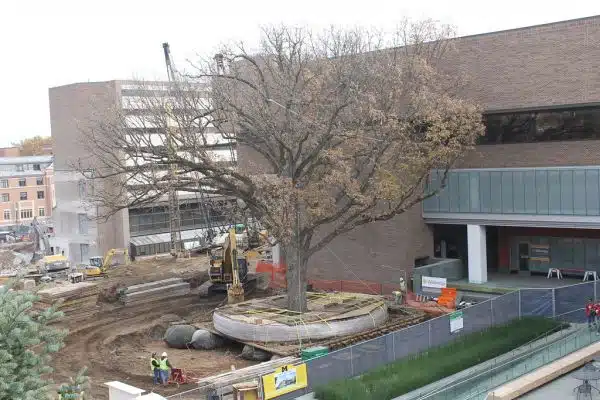Bur Oak is a majestic deciduous tree that thrives in North America. It is a slow-growing tree with a long lifespan, reaching heights of up to 100 feet and living for over 300 years. Bur Oak is known for its beautiful bark, large acorns, and strong branches that make it an excellent shade tree. However, growing and caring for Bur Oak requires specific knowledge and attention to detail.
As arborists or tree care specialists, we understand the importance of maintaining healthy trees in our communities. Growing and caring for Bur Oak can be a rewarding experience that benefits not only the individual but also the environment. In this article, we will provide comprehensive insights on how to grow and care for Bur Oak, from selecting the appropriate site and planting techniques to proper maintenance practices that ensure its longevity. Whether you are a homeowner looking to add a beautiful shade tree to your landscape or an arborist looking to expand your knowledge base, this guide will equip you with practical tips on how to cultivate thriving Bur Oaks.
Understanding Bur Oak’s Natural Habitat
Bur oak is a majestic tree that can grow up to 100 feet tall and 80 feet wide. It is native to the central and eastern regions of North America, covering the natural range from Texas to Manitoba, Canada, and from the Rocky Mountains to the Appalachian Mountains. Bur oak has a deep root system, which makes it well-adapted to withstand drought conditions in open prairies or savannas.
Bur oak can tolerate a wide range of climatic conditions, including hot summers and cold winters. The tree’s natural range includes both humid and arid regions, with precipitation ranging from 20-50 inches per year. While bur oak can survive in areas with high humidity levels, it prefers drier climates with well-drained soils. In extremely wet soils, bur oak may develop root rot or other fungal diseases.
Overall, bur oak’s natural habitat consists of open grasslands and savannas where it has plenty of space to grow its sprawling canopy. It is a hardy species that can thrive in diverse conditions as long as soil drainage is adequate. Understanding bur oak’s natural range and climate adaptation is crucial when selecting an appropriate site for planting this species. With proper care and attention to its environment, bur oak can be a beautiful addition to any landscape.
Moving forward into soil requirements for bur oak growth, it is important to consider how the tree interacts with its environment on a deeper level.
Soil Requirements For Bur Oak Growth
Bur oaks are native to the central and eastern regions of North America, where they thrive in a variety of soil types. However, to ensure optimal growth and health, it is important to understand the specific requirements of this tree species. In the previous section, we discussed the natural habitat of bur oaks. Now, let’s explore how soil conditions affect their growth and what steps you can take to promote healthy development.
One of the most important factors in growing bur oak is improving drainage. This species prefers well-draining soils that are not overly compacted. In areas with heavy clay soils, it may be necessary to amend the soil with organic matter such as compost or leaf mold to increase porosity and improve drainage. Additionally, installing subsurface drains or French drains can help prevent waterlogged conditions that can lead to root rot.
Another key consideration when planting bur oak trees is testing pH levels. These trees prefer slightly acidic soils with a pH range between 6.0 and 7.5. If your soil is too alkaline, adding sulfur or another acidifying agent can be beneficial in lowering pH levels over time. On the other hand, if your soil is too acidic, adding lime or other neutralizing agents can help bring it closer to the ideal range for bur oak growth.
To summarize, proper soil preparation is essential for growing healthy bur oak trees. Improving drainage and testing pH levels are two key factors that should be taken into account when planting these trees. By creating optimal growing conditions through careful soil management practices, you can ensure vigorous growth and longevity for your bur oaks.
When choosing the right location for planting your bur oak tree(s), there are several additional factors that should be considered to promote successful establishment and long-term health.
Choosing The Right Location For Planting
Selecting the right spot for planting is crucial to the success of bur oak growth. The bur oak tree thrives in full sun exposure and requires a spacious area with good air circulation. It can tolerate various soil types, but it prefers well-drained soils that are not waterlogged.
Soil characteristics play a vital role in determining the location for planting bur oak trees. Soil pH should be between 6.0 and 7.5, which is slightly acidic to neutral. Bur oak prefers loamy soil types but will tolerate sandy or clay soils as long as they drain quickly. Avoid areas with compacted or poorly drained soils, which can lead to root rot and other diseases.
Choosing the right location for planting is critical to ensure that your bur oak tree grows healthy and strong. Consider the tree’s mature size when selecting a spot, ensuring it has ample space to develop its canopy without interfering with power lines or buildings. Once you have identified your planting site, you can start preparing the soil for planting by following some essential steps.
Preparing The Soil For Planting
Healthy trees require fertile soil that provides the necessary nutrients for growth. Just as a chef needs quality ingredients to prepare a delicious meal, proper preparation of the soil is essential for successful tree planting. Before planting bur oak, it is important to test the soil to determine its pH and nutrient content. Soil testing methods such as chemical analysis or in-ground tests can help determine the right amendments needed to improve soil quality.
Composting techniques are also useful in preparing the soil for planting bur oak. Composting involves breaking down organic materials into compost, which can then be used as a natural fertilizer. This technique improves soil structure and adds organic matter, providing a healthy environment for tree growth.
When preparing the soil, it is important to ensure that the site has good drainage and that there are no obstructions such as rocks or roots that may impede root growth. Once the site has been prepared, it’s time to move on to plantings techniques for bur oak.
Transitioning into planting techniques, selecting an appropriate location with proper sunlight and drainage is key to ensuring optimal tree health.
Planting Techniques For Bur Oak
When planting a bur oak, it is important to choose the best timing and location. The ideal time to plant would be in the fall or early spring, when the tree is dormant. This will give the tree enough time to establish its root system before facing hot summer temperatures or harsh winter conditions. When selecting a location, make sure it has plenty of sunlight and adequate drainage.
To ensure that your bur oak thrives after planting, proper depth is crucial. The ideal depth for planting a bur oak sapling is at least two times the size of its root ball. This will allow enough space for the roots to spread out and anchor themselves into the soil. A common mistake is planting too deeply, which can cause issues such as suffocating roots or soil compaction.
Mulching techniques and watering tips can also aid in promoting healthy growth for your bur oak. Mulch should be spread around the base of the tree, about 2-3 inches deep but not touching the trunk itself. This helps retain moisture in the soil and regulates temperature around the roots. When watering your bur oak, make sure to give it a deep soak once a week during dry spells rather than frequent shallow watering sessions.
Moving forward, proper watering and fertilizing techniques are essential for maintaining your bur oak’s health and longevity. By following these guidelines, you can ensure that your beloved tree will provide shade, beauty, and benefits for generations to come.
Watering And Fertilizing Bur Oak
To ensure that your bur oak tree grows healthy, you need to provide it with adequate water and nutrients. As an arborist or tree care specialist, we recommend using drought-tolerant watering techniques to conserve water and prevent over-watering. This type of watering method involves deep watering the tree once every two weeks instead of frequent shallow watering that can cause stress to the roots.
Additionally, you can use organic fertilizers to improve soil fertility and provide essential nutrients for your bur oak. Organic fertilizers are made from natural materials that release nutrients slowly into the soil, which helps in promoting healthy root growth and overall plant health. You can apply organic fertilizers during the growing season by either broadcasting or drilling them into the soil.
To make sure that you’re providing your bur oak with the right amount of water and nutrients, you may want to keep track of your watering and fertilization schedule on a calendar. The table below shows an example of a monthly schedule for watering and fertilizing a bur oak:
| Month | Watering Schedule | Fertilizer Application |
|---|---|---|
| March | None | None |
| April | Deep water | Organic fertilizer |
| May | None | None |
| June | Deep water | Organic fertilizer |
| July | None | None |
| August | Deep water | Organic fertilizer |
| Sept | None | None |
| Oct | Deep water | Organic fertilizer |
In summary, using drought-tolerant watering techniques coupled with organic fertilizers is key in maintaining healthy growth for your bur oak tree. Keeping track of your watering and fertilization schedule on a calendar will help ensure that your tree receives proper care throughout each season. In the next section, we will discuss pruning and training bur oaks to help maintain its overall health and shape.
Pruning And Training Bur Oak
Pruning of bur oak trees should be done during the dormant months of winter and early spring. The best pruning method for bur oaks is selective pruning, which is removing damaged, dead, or diseased branches to improve the tree’s overall health and structure. Training techniques such as directional pruning, or selective removal of competing or crossing branches, should be used to create a structurally sound tree with a single leader. Additionally, topping of bur oaks should be avoided as it can lead to decay and decay-related problems. Pruning should be limited to no more than 25% of the tree’s foliage each year. Training of bur oaks should be done when the tree is young, as this will reduce the amount of pruning needed in the future.
Pruning Timing
As a tree care specialist, one of the most common questions I receive from clients regarding bur oak trees is when to prune them. The timing of pruning can greatly affect the health and growth of these majestic trees. Early pruning, which is done in late winter or early spring before new growth appears, is ideal for removing dead or diseased branches and shaping the overall structure of the tree.
Late pruning, on the other hand, should be avoided as it can stimulate new growth that will not have enough time to harden off before winter, leaving it vulnerable to cold damage. Additionally, late pruning can also increase the risk of disease and insect infestation as wounds made during this time take longer to heal. It is important to note that every tree is unique and may require different pruning techniques based on its individual characteristics.
Overall, proper timing of pruning is crucial for maintaining the health and beauty of bur oak trees. By following these guidelines and seeking advice from a certified arborist when needed, homeowners can ensure their trees remain strong and healthy for generations to come. Remember that caring for trees not only benefits us aesthetically but also plays an important role in providing clean air and improving our environment.
Pruning Methods
When it comes to pruning and training bur oak trees, there are several important factors to consider. While the timing of pruning is crucial for the health and growth of these majestic trees, so too are the methods used to prune them. Pruning techniques can vary depending on the individual characteristics of each tree, as well as its overall structure and condition.
One commonly used method for pruning bur oak trees is crown thinning. This technique involves selectively removing branches from the upper portion of the tree’s canopy in order to improve air circulation and reduce weight on certain limbs. Crown thinning can also help to promote new growth by allowing sunlight to penetrate deeper into the tree’s interior.
Another important pruning technique for bur oak trees is crown raising. This involves removing lower branches in order to raise the height of the tree’s canopy and create more clearance underneath. Crown raising can be particularly useful for improving visibility or providing more space for pedestrians or vehicles. However, it should be done carefully in order to avoid damaging any remaining branches or compromising the structural integrity of the tree.
Overall, proper pruning techniques are essential for maintaining healthy and attractive bur oak trees. By understanding when and how to prune these magnificent specimens, homeowners can ensure that they thrive for many years to come while providing important environmental benefits such as shade, clean air, and wildlife habitat.
Training Techniques
Proper pruning and training techniques are crucial when it comes to maintaining the health and longevity of bur oak trees. While pruning involves the selective removal of branches, training focuses on shaping the tree’s growth in a desirable direction. Staking methods and branch bending are two effective training techniques that can help young bur oaks develop strong trunks and branches.
Staking is a common method for providing support to young trees that are at risk of being uprooted or damaged by wind or other environmental factors. This technique involves securing a stake to the ground near the trunk of the tree and tying it to the trunk with a flexible material such as rubber or cloth. The stake should be placed on the side of the tree where it needs support, such as opposite a prevailing wind.
Branch bending is another useful training technique that involves gently bending young branches into desired positions in order to create a more balanced and aesthetically pleasing tree structure. This technique can also help to promote stronger branching patterns by encouraging lateral growth. However, care should be taken not to bend branches too much or too abruptly, as this can cause damage or stress to the tree.
When it comes to training bur oak trees, selecting appropriate staking methods and using proper branch bending techniques can help ensure healthy growth and optimal structural integrity. By taking these steps early on in a tree’s development, homeowners can enjoy their majestic beauty for many years while also reaping important environmental benefits such as shade, clean air, and wildlife habitat.
Dealing With Pest And Disease Issues
Bur oak trees can be affected by various pests and diseases, which can hinder their growth and overall health. To maintain a healthy bur oak tree, it is important to adopt an integrated pest management (IPM) approach. This involves monitoring the tree regularly for any signs of pest or disease issues and taking appropriate measures to control them.
One way to prevent pest and disease problems is by choosing disease-resistant cultivars when planting new bur oaks. These cultivars are bred to be more resistant to common diseases, such as oak wilt and anthracnose. However, even with disease-resistant cultivars, regular monitoring of the tree’s health is still necessary.
If pests or diseases do occur, it is important to take action promptly. Chemical treatments may be necessary in some cases, but non-chemical methods should always be considered first. This includes removing infected branches or leaves, pruning to improve air circulation, and maintaining proper watering and fertilization practices. By adopting an integrated approach that combines prevention with prompt action when needed, you can help ensure your bur oak remains healthy and strong.
By following these tips for preventing and treating pest and disease issues in bur oak trees, you can help protect your investment in your landscape. However, even with the best care practices in place, bur oaks can still experience stress from environmental factors like drought or extreme temperatures. In the next section, we will discuss how to recognize signs of stress in bur oak trees so you can take action before serious damage occurs.
Recognizing Signs Of Stress In Bur Oak
After dealing with pest and disease issues, it is important to pay attention to signs of stress in bur oak trees. Identifying stress early on can prevent further damage or even death of the tree. Some common signs of stress include wilting leaves, yellowing or browning leaves, premature leaf drop, sparse foliage growth, and stunted growth.
Treating the cause of the stress is crucial for the health of the tree. Stress can be caused by a variety of factors such as drought, soil compaction, lack of nutrients, root damage or disease. One way to combat stress is to provide adequate water during periods of drought. Additionally, aerating compacted soil and adding nutrient-rich supplements can improve soil quality which will help strengthen the roots and improve overall health.
In conclusion, identifying and treating stress in bur oak trees is essential for their survival. By recognizing early signs of stress and addressing the underlying issue, arborists and tree care specialists can ensure that these majestic trees continue to thrive for generations to come. In the next section we will discuss how mulching can benefit bur oak trees by improving soil health.
Mulching For Improved Soil Health
What are the benefits of mulching for Bur Oak trees? Mulching is a vital step in maintaining soil health and moisture retention. It also helps to reduce weed growth around the tree base, which can compete with the tree for nutrients and water. Additionally, mulch can regulate soil temperature, keeping it cool during hot summer days and warm during cold winter nights.
There are various types of mulch that can be used for Bur Oak trees. Organic mulches such as wood chips, bark, and leaves decompose over time and enrich the soil with valuable nutrients. Inorganic mulches like rocks or gravel do not decompose but still provide weed control and moisture retention. When choosing a mulch, consider its appearance, availability, cost, and functionality.
Proper mulching techniques are essential to maximize benefits for your Bur Oak tree. Aim to apply 2-4 inches of organic or inorganic material around the base of the tree, leaving a few inches of space between the trunk and the mulch to prevent rotting. Be careful not to pile up too much around the base as it can suffocate roots. Furthermore, avoid using fresh wood chips as they may contain toxins that could harm your tree’s growth.
Now that you know about mulching basics let’s move on to discussing winter protection for your Bur Oak tree.
Winter Protection For Bur Oak
Bur oak is a tough and hardy tree species that can withstand extreme weather conditions. However, it’s still important to provide extra protection for your bur oak during the winter season. One way to do this is by using a winter wrap around the trunk of the tree. This wrap will help to insulate the bark and prevent cracking and splitting from frost damage.
When choosing a winter wrap for your bur oak, look for a material that is breathable and allows air circulation. Avoid using plastic wraps or materials that trap moisture, as this can lead to fungal growth and other issues. The wrap should be applied in late fall before the first frost arrives and removed in early spring when temperatures begin to warm up.
Another way to protect your bur oak from frost damage is by providing adequate water throughout the winter months. A well-hydrated tree is better equipped to handle freezing temperatures than a dehydrated one. Be sure to water deeply before the ground freezes and continue watering periodically throughout the winter if there are extended periods of dry weather.
In conclusion, protecting your bur oak during the winter months is essential for maintaining its health and longevity. By using a winter wrap, providing adequate water, and taking other precautions as needed, you can ensure that your tree stays strong and healthy year-round. Next, we will discuss propagation methods for bur oak, which will help you expand your collection of these beautiful trees!
Propagation Methods For Bur Oak
Winter protection is essential for the survival and health of bur oak trees. However, once the winter season has passed, it is time to focus on the growth and care of these majestic trees. Growing a bur oak requires patience, dedication, and proper knowledge of tree care techniques. In this section, we will discuss seed selection and cutting propagation methods for bur oak.
Seed selection is an important aspect of growing a healthy bur oak tree. When choosing seeds, it is crucial to select those that are disease-free and have high germination rates. It is also important to select seeds that come from parent trees that exhibit desirable traits such as strong root systems, resistance to pests and diseases, and tolerance to harsh weather conditions.
Cutting propagation is another method used in growing bur oaks. This technique involves taking cuttings from healthy parent trees and planting them in soil or rooting hormone until they develop roots. This method can produce genetically identical offspring with the same desirable traits as the parent tree.
Here are some key points to keep in mind when considering seed selection or cutting propagation methods for bur oak:
- Select seeds or cuttings from healthy parent trees
- Choose seeds with high germination rates
- Use rooting hormone when propagating through cuttings
In conclusion, proper seed selection or cutting propagation techniques can greatly improve the chances of growing a healthy bur oak tree. These methods not only ensure genetic diversity but also promote desired traits such as disease resistance and strong root systems. In the next section, we will explore how utilizing bur oak in landscaping can add value to your property while maintaining environmental sustainability.
Utilizing Bur Oak In Landscaping
Bur oak is an excellent tree species to incorporate into landscaping designs. They are large, majestic trees with a wide-spreading canopy that provides ample shade. The Bur oak’s unique characteristics make it popular for use as a shade tree in residential and commercial landscapes alike.
When considering the use of Bur oak in landscaping designs, it is important to understand the tree’s growth habits and requirements. Bur oaks thrive in full sunlight and require well-drained soil to prevent root rot. These trees grow slowly but steadily, reaching heights of up to 100 feet and widths of up to 80 feet. As a result, they should be planted at least 50 feet away from buildings or other structures.
In addition to providing shade, the Bur oak also offers other benefits for landscapers. Its deep roots help stabilize soils and prevent erosion, making it an ideal choice for properties with steep slopes or areas prone to flooding. Furthermore, their acorns provide food for wildlife such as squirrels and deer, adding an extra touch of natural beauty to any landscape design. Overall, incorporating Bur oak into your landscaping design can add both aesthetic appeal and practical value to your property.
As we have seen, Bur oak is an excellent choice for use as a shade tree in landscaping designs due to its unique characteristics such as its wide-spreading canopy and deep roots that help stabilize soils. In the subsequent section, we will explore the many benefits of growing this majestic tree species in greater detail.
Benefits Of Growing Bur Oak
Bur oak is a popular tree species for many reasons, including its benefits to the environment and its aesthetic appeal. One of the most significant advantages of growing bur oak is its ability to sequester carbon. As a hardwood tree, it can store more carbon than other types of vegetation, which means it contributes to reducing greenhouse gas emissions. Additionally, bur oak provides shade and shelter for wildlife, making it an ideal choice for landscaping in rural or suburban areas.
Another benefit of growing bur oak is its longevity. These trees can live up to 300 years when given proper care and are relatively low-maintenance compared to other tree species. They also have a high tolerance for drought, making them ideal for regions with limited water resources. For those looking to create a sustainable landscape that will last for generations, bur oak is an excellent choice.
Growth tips for bur oak include planting in well-drained soil with full sun exposure. It’s important not to overwater the tree as it can lead to root rot and other diseases. Pruning should be done during the dormant season to encourage healthy growth and prevent damage from wind or snow load. With proper care, bur oak can reach heights of up to 100 feet and provide shade and beauty for decades to come.
Transition: Now that we’ve covered the benefits and growth tips for bur oak, let’s move on to frequently asked questions about caring for this magnificent tree species.
Frequently Asked Questions About Bur Oak Care
As the saying goes, “mighty oaks from little acorns grow.” The bur oak, also known as Quercus macrocarpa, is a majestic tree that can live for hundreds of years. To ensure your bur oak grows to its full potential, it’s important to understand how to care for it properly. Here are some frequently asked questions about bur oak care.
What are some common problems that bur oaks face? Bur oaks are generally hardy trees, but they can be susceptible to certain diseases and pests. Some common problems include oak wilt, a fungal disease that can kill trees within weeks; galls, which are abnormal growths on leaves or twigs caused by insects or mites; and spider mites, which can cause discoloration and defoliation. It’s important to identify and address these issues promptly to prevent further damage.
What are some best practices for caring for a bur oak? To keep your bur oak healthy and thriving, there are several best practices you should follow. First and foremost, make sure your tree gets enough water – especially during dry spells. Mulching around the base of the tree can help retain moisture and regulate soil temperature. Additionally, pruning dead or damaged branches can improve air circulation and prevent disease from spreading. Finally, consider fertilizing your tree once or twice a year with a slow-release fertilizer specifically formulated for oaks.
Overall, caring for a bur oak requires diligence and attention to detail. By following these best practices and addressing any common problems promptly, you can help ensure that your tree grows strong and healthy for generations to come. Remember: taking care of our natural resources is an essential part of serving our communities and preserving our planet’s biodiversity.
Conclusion
Bur Oak trees are a valuable addition to any landscape due to their hardiness and longevity. Understanding the natural habitat of this species is essential for successful growth and care. Bur Oaks prefer well-drained soils but are adaptable to various soil types. When selecting a location for planting, consider its mature size as it can reach up to 100 feet tall with a spread of 80 feet.
To prepare the soil for planting, remove any grass or weeds from the area and incorporate organic matter such as compost or aged manure. Planting techniques involve digging a hole twice as wide and deep as the root ball, backfilling with amended soil, and watering thoroughly. Propagation methods include seed germination or grafting.
Utilizing Bur Oak in landscaping provides several benefits such as shade, wildlife habitat, erosion control, and aesthetic appeal. One interesting statistic is that Bur Oaks have been known to live up to 400 years old in their natural habitat, making them living legacies for future generations. By following proper care guidelines, these majestic trees can thrive for centuries to come.
Image Credits





























